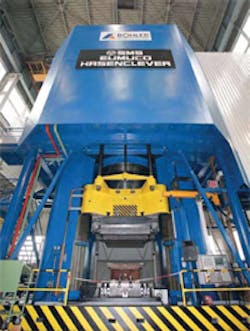Worlds Largest Clutch- Operated Screw Press
Last year, Bhler Schmiedete chnik put into operation the world’s largest hydraulic screw press at its plant in Kapfenberg, Austria. The company is a division of specialty steelmaker Bhler-Uddeholm. The objectives set for this 20-m high press were to double the production capacity, expand the product spectrum, and ensure economical operation.
The order for the Model SPKA 22400N press was placed with SMSEumuco, which subsequently was consolidated with SMS-Meer. Detailed planning began in January 2005.
Purchase of the new screw press was part of a comprehensive investment program by Bhler, estimated at over $40 million. In addition to the screw press, which, including its foundation block, weighs over 6,000 metric tons, Bhler installed a rotary hearth furnace, a die-preheating furnace, and manipulators, as well as the new infrastructure needed for the equipment.
The main product s of Bhler Schmiedetechnik are high-performance forgings of specialty steel, titanium, and nickel-based alloys for production of aircraft, jet engines, and turbines. Every component produced for these applications is subjected to comprehensive qual ity control and documentation. In addition, production processes must be certified according to stringent rules or standards. Already familiar with screw-press technology, Bhler Schmiedetechnik was able to draw on its experience with certification, and hence minimize the time needed for further acceptance procedures.
The clutch-operated screw press makes it possible to form products with high forces, but only brief contact with the forged workpiece. In this way, the technology combines the advantages of a forging hammer (brief contact with the forging) with those of a hydraulic press (high forming forces). The combination was considered ideal for Bhler’s intended product mix.
The enormous forging energy of the clutch-operated screw press is generated by the main flywheel with a diameter of 7.5 m. It is the energy store of the press that rotates with up to 36 RPM and has a moving mass of 590 metric tons. Integrated in the flywheel is the clutch that features a closing force of 40,000 kN and which, during forming, transmits a torque of around 60,000 kNm onto the screw. Within a few mi l l iseconds af ter reaching maximum force, the clutch opens, thereby separating flywheel and screw.
Despite its high forging force, the plant needs a variable-frequency drive power of only 50 0 kW. SMS Meer states that , compared with conventional screw presses, this is a reduction of some 87% at a markedly increased forming energy.
Another special feature of the press is that its impact speed can be varied between 0.25 and 0.5 m/ sec., without losing any of its forming force. This enables product ion of much larger forgings than in the past, so that Bhler Schmiedetechnik is now able to meet the aircraft industry’s growing demand for flexibility, tailored to each customer’s requirements.
Giant components
The press features not only a record rating, but it also uses giant components that were manufactured by European specialist fabricators, based on SMS Meer engineering and under the company’s supervision.
Weighing 340 metr ic tons, the traverse is a real heavyweight. Each one of the four tie rods, which serve to preload the press, weighs 75 metric tons, including nuts. The manufacturing and machining of these giant components posed a great challenge to manufacturing specialists used by SMS Meer.
Construction of this giant press depended on casting and machining two huge components. The 305-metric- ton press table, for example, was manufactured from one casting produced from almost 600 metric tons of liquid steel. The order for the castings went to Sheffield Forgemasters, and the machining was subcontracted to DavyMarkham, which employed its extensive CNC milling and boring resources. Both companies are located in Sheffield, England.
The press table measures 7.5 m long 4 m high 3 m high, and the traverse is similar but higher at 3.25 m. They were cast by SFM using six melts poured into a giant mold, in a carefully planned sequence. After cooling over several days, the castings were heat-treated to enhance metallurgical structure, and surface cleaned, then transported to Davy- Markham for final machining.
Machining was a giant undertaking, reportedly calling upon all of DavyMarkham’s engineering skills and machining resources. Its largest Waldrich Coburg gantry milling machine was programmed from established CNC methodology, to enable circular interpretation-mode milling of large-bore diameters. These tapered bores ranged in diameter from 1,300 to 3,300 mm, with a required accuracy of ±0.1 mm and a geometric tolerance of 0.15 mm between bores, which were up to 4 m apart; only a very sophisticated machine could meet such tight tolerances. To machine these large internal diameters, DavyMarkham designed and manufactured two, large custom boring heads, one for the gantry miller and one for a horizontal borer.
Shot peening was used at certain critical radii, too, to enhance fatigue limits of the material and prevent crack initiation. The finish-machined traverse casting finally weighed just over 325 metric tons, including a series of 2,50 0 mm diameter, 3-metric ton alloy steel rings, also produced by DavyMarkham, while the machined table weighed 300 metric tons.
Teaming up with heavytransport contractors, the giant components were transported to their destination by water, special railway wagon, and extralarge trucks , travel ing on special routes across partly reinforced bridges and through enlarged tunnels.
Extensive testing was started at the beginning of 2007, and as early as July 2007 the press successfully went into commercial production.
